3 - Time Value of Money - Part 2 (Annuities, DCF Valuation)
Chapter 3 The Time Value of Money 货币的时间价值 财务管理(双语版) 教学课件

年金现值:PVAn(Present Value of an Ordinary Annuity)
n 1
11i n
PV nR A t 11it R i
R PVi,nI
PVIFAi,n 年金现值系数(the Present Value Interest Factor of an Annuity at i for n periods)
P0V P 0FnV 1inFnV PVi,nIF
7. PVIFi,n : (the Present Value Interest Factor at i for n
periods)
8.
复利现值系数,利率为i,期数为n
6. Annuities 年金
系列、等额的收付
Ordinary Annuity 普通年金 收付款发生于每期期末 Annuity Due 预(即)付年金 收付款发生于每期期初
Perpetuity 永续年金
无限期支付的普通年金
Ordinary Annuity(普通年金)
0
R
R
R
R
年金终值:FVAn(Future Value of an Annuity)
FV nR A t n11intR1iin1RFVi,nIFA
FVIFAi,n 年金终值系数(the Future Value Interest Factor of an Annuity at i for n periods)
1
每年计息一次时产生的利息=名义利率每年计息m次时产生的利息
FV n A R F DV i,n 1 I 1 FA
现值 (Present Value)
比普通年金少折现一期
PV n A R P D V i,nI 1 F i A
货币的时间价值
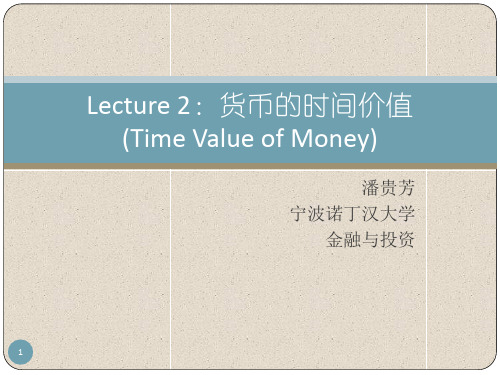
14
普通年金终值计算:
更一般的, 假设每年收付的金额为A, 利率为i, 期数为n, 则计算复利终值的年金终值FVAn的公 式如下:
从这个公式可以看出来, 这是一个等比数列求 和公式, 简化后可以得到:
记:
15
普通年金终值计算:
例6:某父母为孩子在10年后上大学准备5万元 钱, 假设银行的存款年利率为6%, 复利计息, 那么在这10年中, 每年年末要存入多少元?
Lecture 2:货币的时间价值 (Time Value of Money)
潘贵芳 宁波诺丁汉大学
金融与投资
1
教学内容:
货币的时间价值 单利/复利的现值与终值 年金(普通年金、预付年金、递延年金、永
续年金) 货币时间价值应用中的几个问题 (利率或
折现率、期限、名义利率和实Fra bibliotek利率)2
货币的时间价值概述:
10
复利计息现值与终值:
例4 (改例3, p6):王先生计划于5年后买车, 需购车款13万元, 王先生打算现在存笔钱到银 行, 5年后正好用于购车, 银行目前的存款利 率为6%, 且复利计息,一年一计, 则王先生需 要存入的金额为:
PV=13*(P/F,6%,5)=13*0.7473=9.71 (万元) 按单利计息时,王先生需要存入10万元,而当
这一问题, 第二年计算利息的本金是上一年的年末终值, 也就是1080, 又再按8%的利息计算, 也就是说 FV2=FV1*(1+i)=PV*(1+i)*(1+i)=PV*(1+i)2 =1000*(1+8%)2 =1166.4元 第三年末, 该账户金额为: FV3=FV2*(1+i)=PV*(1+i)2(1+i)=PV(1+i)3=1000*(1+8%) 3=1259.7元 所以, 更一般的, 在第n年末, 该账户的终值FVn应该为: FVn=PV (1+i)n=PV (F/P, i, n) (p.25)
time value of money

• How much money do you have at the end of the year?
• The number of compounding period (n) may not be the same as the number of years.
14
Periodic vs. Annual
• The annual rate must be converted to periodic rate if compounding is taking place more often than once a year.
• The number of Compounding periods (n).
6
SINGLE AMOUNT
• Consider only two cash flows, one at the beginning and one at the end of the period.
• Application - place some money in your saving account today and withdraw the proceeds in the future.
26
Present Value of Perpetuity
• Present Value of Perpetuity
PV = PMT/r
27
Annuity
• An annuity is a series of payments of equal amount.
财务管理基础课件:The Time Value of Money
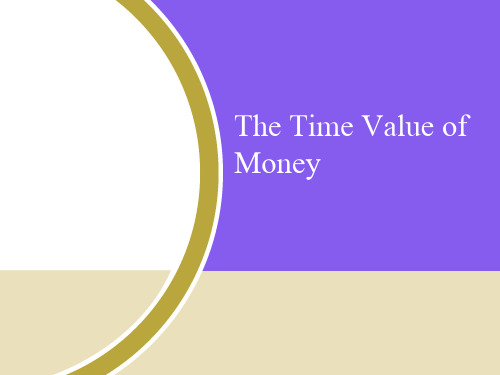
Where FV = Future value PV = Present value i = Interest rate n = Number of periods;
In the previous case, PV = $1,000, i = 10%, n = 4, hence;
1st year……$1,000 X 1.10 = $1,100 2nd year…...$1,100 X 1.10 = $1,210 3rd year……$1,210 X 1.10 = $1,331 4th year……$1,331 X 1.10 = $1,464
9-4
Future Value – Single Amount (Cont’d)
• The time value of money is used to determine whether future benefits are sufficiently large to justify current outlays
• Mathematical tools of the time value of money are used in making capital allocation decisions
annuity
9-25
Yield – Present Value of a Single Amount
• To calculate the yield on an investment producing $1,464 after 4 years having a present value of $1,000:
Table 9–5
Time value of money课后习题答案
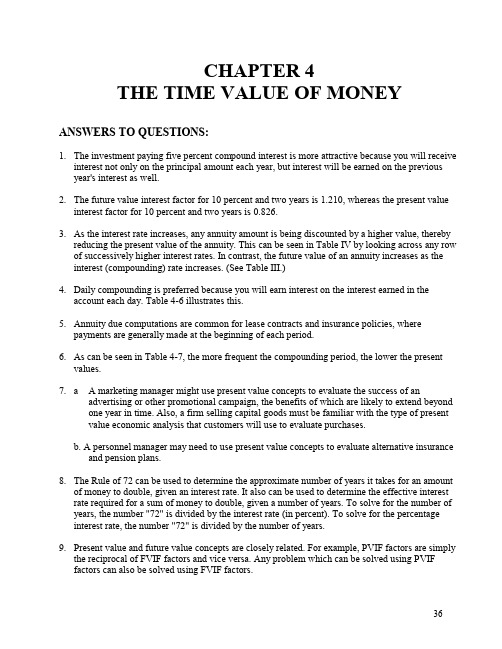
2. a Present value of $5,000 today = $5,000 b. Present value of $15,000 received in 5 years at 9%: PV0 = $15,000(PVIF.09,5) = $15,000 (0.650) = $9,750 (calculator solution = $9,748.97) c. Present value of a 15 year, $1,000 annuity at 9%: PVAN0 = $1,000 (PVIFA.09,15) = $1,000(8.061) = $8,061 (calculator solution = $8,060.69) Therefore, you prefer $15,000 in five years because it has the highest present value.
CHAPTER 4 THE TIME VALUE The investment paying five percent compound interest is more attractive because you will receive interest not only on the principal amount each year, but interest will be earned on the previous year's interest as well. 2. The future value interest factor for 10 percent and two years is 1.210, whereas the present value interest factor for 10 percent and two years is 0.826. 3. As the interest rate increases, any annuity amount is being discounted by a higher value, thereby reducing the present value of the annuity. This can be seen in Table IV by looking across any row of successively higher interest rates. In contrast, the future value of an annuity increases as the interest (compounding) rate increases. (See Table III.) 4. Daily compounding is preferred because you will earn interest on the interest earned in the account each day. Table 4-6 illustrates this. 5. Annuity due computations are common for lease contracts and insurance policies, where payments are generally made at the beginning of each period. 6. As can be seen in Table 4-7, the more frequent the compounding period, the lower the present values. 7. a A marketing manager might use present value concepts to evaluate the success of an advertising or other promotional campaign, the benefits of which are likely to extend beyond one year in time. Also, a firm selling capital goods must be familiar with the type of present value economic analysis that customers will use to evaluate purchases.
第三章 货币的时间价值 chapter3- Time value of money
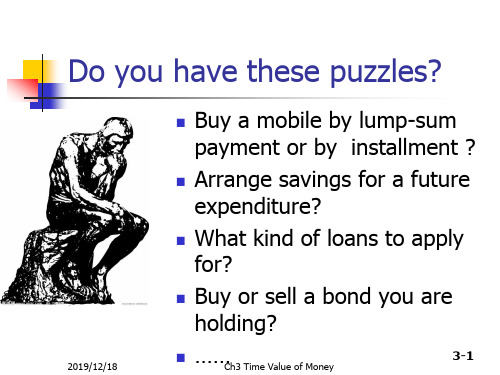
After 2 years:
FV2 = PV ( 1 + i )2 = $100 (1.10)2 =$121.00
After 3 years:
FV3 = PV ( 1 + i )3 = $100 (1.10)3 =$133.10
After n years (general case):
3-2
To find the answer, you’ll have to know
CH3 The Time Value of Money
2019/12/18
Ch3 Time Value of Money
3-3
3.1 Compounding and Discounting Single Sums
3-9
Compounding:
To find the Future Value (FV) of a cash flow, we suppose we earn interest on
principal as well as on interest
accumulated each term.
Today
Future
?
2019/12/18
Ch3 Time Value of Money
3-6
Time lines
0
1
2
3
i%
CF0
CF1
CF2
CF3
Show the timing of cash flows.
Tick marks occur at the end of periods, so Time 0 is today; Time 1 is the end of the first period (year, month, etc.) or the beginning of the second period.
finance Time Value of Money(2)
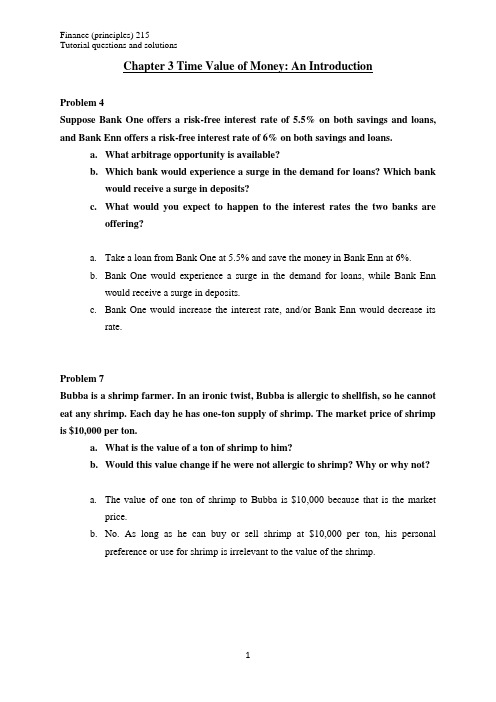
Chapter 3 Time Value of Money: An IntroductionProblem 4Suppose Bank One offers a risk-free interest rate of 5.5% on both savings and loans, and Bank Enn offers a risk-free interest rate of 6% on both savings and loans.a.What arbitrage opportunity is available?b.Which bank would experience a surge in the demand for loans? Which bankwould receive a surge in deposits?c.What would you expect to happen to the interest rates the two banks areoffering?a.Take a loan from Bank One at 5.5% and save the money in Bank Enn at 6%.b.Bank One would experience a surge in the demand for loans, while Bank Ennwould receive a surge in deposits.c.Bank One would increase the interest rate, and/or Bank Enn would decrease itsrate.Problem 7Bubba is a shrimp farmer. In an ironic twist, Bubba is allergic to shellfish, so he cannot eat any shrimp. Each day he has one-ton supply of shrimp. The market price of shrimp is $10,000 per ton.a.What is the value of a ton of shrimp to him?b.Would this value change if he were not allergic to shrimp? Why or why not?a.The value of one ton of shrimp to Bubba is $10,000 because that is the marketprice.b.No. As long as he can buy or sell shrimp at $10,000 per ton, his personalpreference or use for shrimp is irrelevant to the value of the shrimp.Problem 11A friend asks to borrow $55 from you and in return will pay you $58 in one year. If your bank is offering a 6% interest rate on deposits and loans:a. How much would you have in one year if you deposited the $55 instead?b. How much money could you borrow today is you pay the bank $58 in one year?c. Should you loan the money to your friend or deposit it in the bank?a. I f you deposit the money in the bank today you will have:$1.06 in one year FV $55 today $58.30 in one year $ today ⎛⎫=⨯= ⎪⎝⎭b.If you lend the money to your friend for one year and borrow against the promised $58 repayment, then you could borrow:$1.06 in one year PV $58 in one year $54.72 today $ today ⎛⎫=÷= ⎪⎝⎭c. F rom a financial perspective, you should deposit the money in the bank, as it will result in more money for you at the end of the year.Problem 16Calculate the future value of $2000 ina. Five years at an interest rate of 5% per year.b. Ten years at an interest rate of 5% per year.c. Five years at an interest rate of 10% per year.d. Why is the amount of interest earned in part (a) less than half the amount of interest earned in part (b)?a. Timeline:0 1 2 555FV 2,000 1.052,552.56=⨯=b. Timeline:0 1 2 101010FV 2,000 1.053,257.79=⨯=c. Timeline:0 1 2 555FV 2,000 1.13,221.02=⨯=d. Because in the last 5 years you get interest on the interest earned in the first 5 years as well as interest on the original $2,000.Problem 22Your grandfather put some money in an account for you on the day you were born. You are now 18 years old and are allowed to withdraw the money for the first time. The account currently has $3996 in it and pays an 8% interest rate.a. How much money would be in the account if you left the money there until your 25th birthday?b. What if you left the money until your 65th birthday?c. How much money did your grandfather originally put in the account?a. Timeline:18 19 20 21 25 0 1 2 3 77FV 3,996(1.08)6,848.44==b. Timeline:18 19 20 21 65 0 1 2 3 4747FV 3,996(1.08)148,779==c. Timeline:0 1 2 3 4 18183,996PV 1,0001.08==Chapter 4 Time Value of Money: Valuing Cash Flow StreamsProblem 1You have just taken out a five-year loan from a bank to buy an engagement ring. The ring costs $5000. You plan to put down $1000 and borrow $4000. You will need to make annual payments of $1000 at the end of each year. Show the timeline of the loan from your perspective. How would the timeline differ if you created it from the bank’s perspective?0 1 2 3 4 5From the bank’s perspective, the timeline is the same except all the signs are reversed.Problem 9The British government has a consol bond outstanding paying £100 per year forever. Assume the current interest rate is 4% per year.a. What is the value of the bond immediately after a payment is made?b. What is the value of the bond immediately before a payment is made? Timeline:0 12 3a. The value of the bond is equal to the present value of the cash flows. By the perpetuity formula:100PV 2,500.0.04£==b. The value of the bond is equal to the present value of the cash flows. The cash flows are the perpetuity plus the payment that will be received immediately.PV =100+100=£2,600 Problem 30You are saving for retirement. To live comfortably, you decide you will need to save $2 million by the time you are 65. Today is your 30th birthday, and you decide, starting today and continuing on every birthday up to and including your 65th birthday, that you will put the same amount into a savings account. If the interest rate is 5%, how much must you set aside each year to make sure that you will have $2 million in the account on your 65th birthday? Timeline:30 31 32 33 65 0 12 3 35FV = $2 millionThe PV of the cash flows must equal the PV of $2 million in 35 years. The cash flows consist of a 35-year annuity, plus the contribution today, so the PV is:()35C 1PV 1 C.0.05 1.05=-+⎛⎫ ⎪⎝⎭The PV of $2 million in 35 years is()352,000,000$362,580.57.1.05=Setting these equal gives:()()3535C 11C 362,580.570.05 1.05362,580.57C $20,868.91.11110.05 1.05-+=⇒==-+⎛⎫⎪⎝⎭⎛⎫⎪⎝⎭。
finance Time Value of Money(2)

Chapter 3 Time Value of Money: An IntroductionProblem 4Suppose Bank One offers a risk-free interest rate of 5.5% on both savings and loans, and Bank Enn offers a risk-free interest rate of 6% on both savings and loans.a.What arbitrage opportunity is available?b.Which bank would experience a surge in the demand for loans? Which bankwould receive a surge in deposits?c.What would you expect to happen to the interest rates the two banks areoffering?a.Take a loan from Bank One at 5.5% and save the money in Bank Enn at 6%.b.Bank One would experience a surge in the demand for loans, while Bank Ennwould receive a surge in deposits.c.Bank One would increase the interest rate, and/or Bank Enn would decrease itsrate.Problem 7Bubba is a shrimp farmer. In an ironic twist, Bubba is allergic to shellfish, so he cannot eat any shrimp. Each day he has one-ton supply of shrimp. The market price of shrimp is $10,000 per ton.a.What is the value of a ton of shrimp to him?b.Would this value change if he were not allergic to shrimp? Why or why not?a.The value of one ton of shrimp to Bubba is $10,000 because that is the marketprice.b.No. As long as he can buy or sell shrimp at $10,000 per ton, his personalpreference or use for shrimp is irrelevant to the value of the shrimp.Problem 11A friend asks to borrow $55 from you and in return will pay you $58 in one year. If your bank is offering a 6% interest rate on deposits and loans:a. How much would you have in one year if you deposited the $55 instead?b. How much money could you borrow today is you pay the bank $58 in one year?c. Should you loan the money to your friend or deposit it in the bank?a. I f you deposit the money in the bank today you will have:$1.06 in one year FV $55 today $58.30 in one year $ today ⎛⎫=⨯= ⎪⎝⎭b.If you lend the money to your friend for one year and borrow against the promised $58 repayment, then you could borrow:$1.06 in one year PV $58 in one year $54.72 today $ today ⎛⎫=÷= ⎪⎝⎭c. F rom a financial perspective, you should deposit the money in the bank, as it will result in more money for you at the end of the year.Problem 16Calculate the future value of $2000 ina. Five years at an interest rate of 5% per year.b. Ten years at an interest rate of 5% per year.c. Five years at an interest rate of 10% per year.d. Why is the amount of interest earned in part (a) less than half the amount of interest earned in part (b)?a. Timeline:0 1 2 555FV 2,000 1.052,552.56=⨯=b. Timeline:0 1 2 101010FV 2,000 1.053,257.79=⨯=c. Timeline:0 1 2 555FV 2,000 1.13,221.02=⨯=d. Because in the last 5 years you get interest on the interest earned in the first 5 years as well as interest on the original $2,000.Problem 22Your grandfather put some money in an account for you on the day you were born. You are now 18 years old and are allowed to withdraw the money for the first time. The account currently has $3996 in it and pays an 8% interest rate.a. How much money would be in the account if you left the money there until your 25th birthday?b. What if you left the money until your 65th birthday?c. How much money did your grandfather originally put in the account?a. Timeline:18 19 20 21 25 0 1 2 3 77FV 3,996(1.08)6,848.44==b. Timeline:18 19 20 21 65 0 1 2 3 4747FV 3,996(1.08)148,779==c. Timeline:0 1 2 3 4 18183,996PV 1,0001.08==Chapter 4 Time Value of Money: Valuing Cash Flow StreamsProblem 1You have just taken out a five-year loan from a bank to buy an engagement ring. The ring costs $5000. You plan to put down $1000 and borrow $4000. You will need to make annual payments of $1000 at the end of each year. Show the timeline of the loan from your perspective. How would the timeline differ if you created it from the bank’s perspective?0 1 2 3 4 5From the bank’s perspective, the timeline is the same except all the signs are reversed.Problem 9The British government has a consol bond outstanding paying £100 per year forever. Assume the current interest rate is 4% per year.a. What is the value of the bond immediately after a payment is made?b. What is the value of the bond immediately before a payment is made? Timeline:0 12 3a. The value of the bond is equal to the present value of the cash flows. By the perpetuity formula:100PV 2,500.0.04£==b. The value of the bond is equal to the present value of the cash flows. The cash flows are the perpetuity plus the payment that will be received immediately.PV =100+100=£2,600 Problem 30You are saving for retirement. To live comfortably, you decide you will need to save $2 million by the time you are 65. Today is your 30th birthday, and you decide, starting today and continuing on every birthday up to and including your 65th birthday, that you will put the same amount into a savings account. If the interest rate is 5%, how much must you set aside each year to make sure that you will have $2 million in the account on your 65th birthday? Timeline:30 31 32 33 65 0 12 3 35FV = $2 millionThe PV of the cash flows must equal the PV of $2 million in 35 years. The cash flows consist of a 35-year annuity, plus the contribution today, so the PV is:()35C 1PV 1 C.0.05 1.05=-+⎛⎫ ⎪⎝⎭The PV of $2 million in 35 years is()352,000,000$362,580.57.1.05=Setting these equal gives:()()3535C 11C 362,580.570.05 1.05362,580.57C $20,868.91.11110.05 1.05-+=⇒==-+⎛⎫⎪⎝⎭⎛⎫⎪⎝⎭。
- 1、下载文档前请自行甄别文档内容的完整性,平台不提供额外的编辑、内容补充、找答案等附加服务。
- 2、"仅部分预览"的文档,不可在线预览部分如存在完整性等问题,可反馈申请退款(可完整预览的文档不适用该条件!)。
- 3、如文档侵犯您的权益,请联系客服反馈,我们会尽快为您处理(人工客服工作时间:9:00-18:30)。
2-3; CN19
You deposit $100 per year for three years, with the first deposit made one year from now (ordinary annuity) into an account earning 7% interest per year. How much will you have in the account after you make the last deposit?
$1000
$1000 (1.07)3
$1000
$934.58 873.44 816.30 762.90 712.99 $4,100.20
$1000 (1.07)4
$1000 (1.07)5
Time 0: No cash flow Time 1: First $1,000 payment; discount one period at 7%: $1,000/(1.07)1 $934.58 Time 2: Second $1,000 payment; discount two periods at 7%; $1,000/(1.07)2 873.44 Time 3: Third $1,000 payment; discount 2-11;three CN22 periods at 7%; $1,000/(1.07)3
Calculator solution: N I/Y
PV
PMT
FV
216 mos.
Annual PMT amount
.66 per mo.PMT =
0
CPT
$208.30
100,000
2,670.21 ≈ 222.52, which is > than 208.30 (the monthly payment) 12 mos.
Annuities DUE have the payments come due at the beginning of the period. Example: rent, commercial leases
2-2; CN19
Think of the future value of an annuity (FVA) as the SUM OF THE FUTURE VALUES OF EACH INDIVIDUAL CASH FLOW in the annuity stream. After all, each cash flow could be placed in a separate account, but when you go to withdraw your funds you will be concerned with the sum of all the future values together. We say that future values are ADDITIVE. FVIFA = FVIF – 1 = (1 + r)t – 1 r r Annuity future value = PMT x FVIFA
If
we call 1 – (1/(1 + r)t)
2-9; CN21
the present value interest
Example 2.11
(Present Value of an Ordinary Annuity and Annuity Due) 2.11a. is the end of each year for the next 5 years, discounted at (present value of an ordinary annuity) What
(Present Value of an Ordinary Annuity and Annuity Due) 2.11b (present value of an annuity due) If the payments were made at the beginning of each period, we bring the present value of each payment forward one period by multiplying (1 + r). This is called an annuity due. 4,100.20 x (1 + .07) = 4,387.21
PV1 = 100 = 100
(1.1)1 (1.1)2
+
PV2 = 100
+
PV3
(1.1)3
PVA
=
90.91 2-8; CN21 +
82.64
+
Example 2.10 (Cont.)
(Present Value of an Annuity)
Notice
how the present value of each payment decreases as the $100 is received farther and farther into the future (i.e., the PV of the first payment is greater than the second or third…). Thus, the present value of an annuity equals the sum of the present values of each payment in the annuity stream. That is what we mean by PVs being additive. We can show that PMT x [(1 – (1/(1 + r)t)] = Present value of r an Annuity (PVA)
PVADUE = PVAORD x (1 + r) = $4,100.20 x 1.07 = 4,387.21 • Likewise, the future value of an annuity due is calculated as follows: FVADUE = FVAORD x (1 + r)
2-13; CN23
Example 2.11 (Cont.)
2.11b Annuity Due
0 4 5
$1000 $0 0 (1.07)
1
2
3
$1000
$1000 (1.07)1
$1000
$1000 (1.07)2
$1000
$1000
$1000
$1,000.00 934.58 873.44 816.30 762.90 $4,387.21
Your display should NOT say “BGN”
N
I/Y
PV
PMT
FV
3 years
7 per yr.
0
-100
CPT
FVAORD =
$321.49
2-5; CN19
In order to accumulate $100,000 in the kid’s college fund by age 18, what is the annual payment that must be invested if your investment yields 8% per year? Start on the child’s first birthday (this is an ordinary annuity).
present value of $1,000 to be received at the
7%?
2-10; CN22
Example 2.11 (Cont.)
2.11a Ordinary Annuity
0 4
$0 $1000
1 5
$1000 $1000 1 (1.07)
2
3
$1000
$1000 (1.07)2
$1000 (1.07)3
$1000 (1.07)4
Time 0: First $1,000 payment; discount zero periods at 7%: $1,000/(1.07)0 $1,000.00 Time 1: Second $1,000 payment; discount one periods at 7%: $1,000/(1.07)1 = 934.58 Time 2: Third $1,000 payment; discount one periods at 7%; $1,000/(1.07)2 873.44 2-14; CN23
Annuities Annuity: A level stream of cash flows for a fixed period of time, a constant period apart.
ORDINARY annuities have the payments come at the end of the period. Example: car/house payment
0 $0
1
2
$100 x (1100 $100 x (1.07)1 $100.00 $100 x (1.07)2 107.00 114.49 2-4; CN19 FVA = $321.49
Use the financial calculator: FIRST: 2nd CLR TVM
=
=
Example 2.11 (Cont.)
• Rather than use the “BEG” feature on the financial calculator for an annuity due, just add one period of interest to the ordinary annuity result for each cash flow (to the overall total) as computed in 6.4a:
